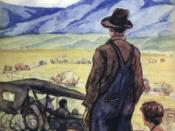John Steinbeck, an established Californian author, wrote many novels about the situations of the common man in the state. In particular, he addressed the Depression era and the years shortly thereafter through two of his most famous novels, The Grapes of Wrath and Cannery Row. Both novels centered on people who were not well off socially or economically. Steinbeck used his novels to portray messages and gain sympathy for the causes he wrote about. Through capturing the essence of the typical lifestyle of the common man, Steinbeck is able to convey his belief that individuals can bond together to create a more powerful group.
In The Grapes of Wrath, Steinbeck follows the Joad family from the beginning of the Dust Bowl era of the Midwest to their attempts at a new life in the orchards and fields of California. The Joads, faced with no other choice, head to California in order to seek a more profitable job.
However, when they reach the Golden State along with other people in the same condition, they find difficult jobs that give little pay. The novel depicts the struggle between the farm workers and the owners as an epic struggle between good and evil in order to gain sympathy for the laborer's cause. Since the orchard owners were so set on keeping wages down to increase profits, they bribed the law onto their side to disrupt and destroy any attempt of laborers to organize into a union.
Steinbeck displays the Depression era extremely realistically. He writes using the dialect of the time period, and portrays an accurate description of the sacrafices made by the refugees in order to show the reader what happened during this period. Still, The Grapes of Wrath is a piece of propaganda, designed to gain sympathy and support for the laborers. Since Steinbeck was in support of the people, one of the main issues that he believed in was that a labor union was necessary to unite the workers and provide basic secure rights, such as a minimum wage. He demonstrates that idea with Jim Casy, a central character. Steinbeck's writing was to spread a belief he upheld strongly, so he proved his points by using realism.
In another novel focusing on the down and out people of California, Cannery Row focuses on the actions of citizens of a poor part of Monterey. The novel has no main message like The Grapes of Wrath. Instead, it serves to capture the essence of poor life, and display it to the world solely for the purpose of having the general public understand. The story of Cannery Row follows the adventures of Mack and the boys, a group of unemployed yet resourceful men who inhabit a converted shack on the edge of a vacant lot down on the Row. Also living on Cannery Row is Doc, a very kind and generous man that is willing to help out the denziens of the area. Mack and the boys want to do something nice for Doc, so they decide to throw him a party. After one failed attempt, they have a second party and all is well.
Cannery Row does not try and sell a point to its readers. Rather, it displays a point and it is purely the reader's choice to accept the idea. Cannery Row serves simply as information. To present an accurate description of life at the time period, Steinbeck again uses techniques such as realism and dialect to portray life at the lower levels. He demonstrates using these techniques that the only people who can help other poor people are poor people themselves. Such is shown by the "ÃÂbrotherhood' attitude between Mack and his friends. The stereotypical characters used are also great examples. For instance, there is Dora, the gruff madam with the heart of gold. Lee, the grocer who is a tough and even extortionary businessman but who nevertheless keeps the Row going and is capable of extreme generosity. Finally there is Doc, the shiftless man who can't hold a job but will tenderly nurse a puppy back to health. Each person is portrayed realistically by Steinbeck through use of regionalistic writing, and they end up supporting each other as best as they can.
Steinbeck obviously believed that the only people who would help out people down on their luck were people in the same situation: "She started for the door, and when she reached it, she turned about. "ÃÂI'm learnin' one thing good,' she said. "ÃÂLearnin' it all a time, ever' day. If you're in trouble or hurt or need "" go to poor people. They're the only ones that will help. The only ones.' The screen door slammed shut behind her." (Grapes of Wrath, 415) Since Steinbeck's novels concentrated on the people who were poor, he was able to show how they survived. As the individual families were divided and forced apart during the migrations to California, they united not by family ties but by a common goal. In order to survive in California, they developed a new family that was bound by their economic situations. In that way, even though they had little to give, they would help each other to gain much more.
Both novels present a strong realistic theme throughout the novel. Because of this theme, Steinbeck was allowed to clearly present one of his own beliefs into the novel. The essence of life for these people was one of generosity and kindness. By understanding their situations and the possibilities they had open to them, it is clear to see how the power of a group could do so much more than a single individual.





